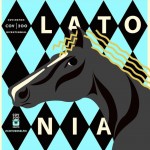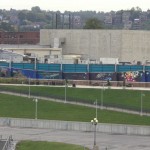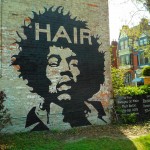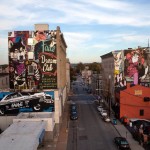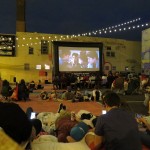Covington is an ‘unapologetically authentic’ place. It’s an island unto itself. No label, declarative statement, or stereotype quite fits the business owners and residents who live here. What can be said is what unites them: their belief in community, their value placed on the arts and creativity, and their passion and pride for the city.
Early in the fall ArtWorks and the Cincinnati of Cincinnati announced October as Mural Month, a month-long celebration of urban art. Although intended for the Queen City audience, this declaration provides a unique opportunity to survey the purveyors of murals in Northern Kentucky and discuss why they are at the heart of making Covington a destination and haven for creativity.
During the last six years, Covington amassed an incredible collection of public murals created and/or commissioned by individuals, businesses and organizations interested in humanizing our built environment. The creators span the ranks of artisans, from youth apprentices to local and regional professionals, from national talent to international super-stars. Working together, the murals invigorate the city with their social value and visual impact, instilling the community with a sense of place.
Covington’s riverfront is home to The Roebling Murals by Robert Dafford and include eighteen works spanning the length of 1,000 feet of the flood wall. The subjects of the murals depict the rich history of Covington, Northern Kentucky and the Suspension bridge. Spearheaded by the Legacy group, the project encouraged young leaders to embrace principles of meaningful participation with economic well-being of the region.
Mark Brawley, artist and resident of Mainstrasse Village, lays claim to the neo-pop inspired portrait murals dotting buildings along the Main Street corridor. Quirky and cool, his black and white renditions of Jimi Hendrix and Andy Warhol provide intense encounters with icons from generations past. Although they are not technically sanctioned by proper authorities, his under-the-cloak-of- darkness installation tactics are amusing and provide fodder for the critics.
Pioneers of the mural movement in Covington, BLDG is an art gallery/branding & design firm located on Short Pike Street. Adding texture to the urban fabric of the city, their contribution to the public arts scene in Covington is twofold: branded and fine art murals. (Full disclosure, I recently married one of the partners).
On the brand side, BLDG designs and executes murals for projects like the COV200, the group of volunteers organizing the city’s upcoming bicentennial celebration. The murals act as activations or campaigns for COV200: examples include locations announcing the bicentennial on Scott & 6th Street and the ‘selfie-murals’ located in each of Covington’s nineteen neighborhoods. These murals consciously seek audience engagement and participation with social media; the goal is to help tell the story of local residents with creative spots in the community. Once completed, at least 20 murals will be added to the city’s repertoire.
On the fine-art side, BLDG invites renowned urban artists from around the world to contribute to the thriving mural scene in Covington. They are responsible for bringing groups like The London Police and most recently Brooklyn-based duo Faile to the city. TLP created ten murals throughout Covington, highlighting unique locales and businesses in the area. Then a walking tour was created encouraging interested parties to explore. Faile completed a massive installation spanning two buildings flanking the sides of 6th Street. Their comic-book style imagery and intense array of colors creates a jaw-dropping experience from nearly any vantage point.
ArtWorks, too, has a footprint in Northern Kentucky. A total of ten murals gracing the walls of Bellevue, Covington and Newport. The compositions and subject matter are diverse and often reflect aspects of the places where they are located.
In Newport, the Shining Seas mural at the aquarium celebrates the institution’s 15th anniversary with a massive composition teaming with sundry sea creatures and animals of the life aquatic. Covington is home to more than a handful including The Divine Proportion of All Things on 7th Street, Kentucky Natural History on Scott & 5th, Sunset Walk through Helentown on 15th street and Epic of Time and Town in MainStrasse. These murals employ techniques like abstraction, illustration, and tromp l’oeil and span the depth of subjects and styles.
Since 1996 ArtWorks has employed over 2,500 youth apprentices and 700 professional artists and contributed $1.3 million to the local economy through wages and meaningful employment. What ArtWorks does very successfully is engage communities with local and regional talent throughout the entire process of their installations. From inception to creation and final dedication of all their mural projects, they have refined and perfected their process. No doubt a force to be reckoned with, their contributions to the realm of public art must be recognized and commended as they are truly inspiring.
With varying degrees of scope and scale these projects beg the question, why Covington?
Nearly twelve years ago, Richard Florida published The Rise of the Creative Class (2002) a seminal publication touting the importance of the creative ethos and suggesting its influence on the economics of revitalization. Although many of his proclamations are hotly contested, his insights inspired a new trend with development enthusiasts, one where arts, creativity and a sense of place exist at the heart of planning strategies for cities.
Covington is a perfect example of Florida’s influence.
Rewind back to 2006, when the City of Covington created the Covington Arts district and established the Artisans Enterprise Center (AEC). As a small city with limited resources, these well-intentioned ideas faced an uphill battle.
The arts district demonstrating a top-down approach and arbitrary creation of a “district,” was premature. Not only did the boundaries of the district exclude important arts organizations like The Carnegie and Behringer-Crawford Museum, it lacked a critical mass of engaged people living within its boundaries to support the businesses, galleries, and shops in order for that effort to be sustained and thrive. Lesson learned.
The AEC, on the other hand, was a community resource center and art gallery available to the public. It was also the headquartered office of the Cultural Arts Director, who serves as liaison for creative collaboration between the city, arts and cultural organizations and businesses in the private sector. Over the last six years, Covington’s support of the mural movement witnessed the acquisition of over 60 + public works throughout the city.
What attracts us to live somewhere? Shops and restaurants? Good schools? Walkability? From a municipal perspective, cities gain value through public art. It often reflects the beliefs of a community and showcases its identity and uniqueness. Americans for the Arts argues, “Public art creates civic icons and transforms streetscapes, parks and heavily trafficked areas into vibrant expressions of human imagination. In this capacity artists and creative groups function as civic and social leaders. Through public art, they contribute to an active and dynamic cultural scene which is more attractive to individuals and businesses.”[i]
Typically people want all of these things, but an emerging trend on the development radar is the attractiveness of ‘creative-places.’ Murals are absolutely a part of making public space unique but the contextualizing space with programming and an experience is what makes the creative haven sing.
A perfect example of this kind of place in Covington is the MadLot on the corner of 7th & Washington Streets. Driven by a unique partnership between Renaissance Covington and MKSK (urban design and landscape architecture firm) along with a host of collaborators, a relatively drab parking lot was transformed into a pop-up performance park, complete with a stage, night-time lighting and hand painted pink and blue way finding throughout the lot. During the warm months of the year, the MadLot hosted free events for urbanites from all walks of life to enjoy such as Park(ing) Day, pop-up movie screenings, and musical performances.
Years ago in a life past, there was ‘a girl’ who played the role of gallerina for a commercial art gallery in Cincinnati. In big cities or small her role is a familiar one, the steward of the desk. Undeniably, this role served a purpose but more importantly it gave ‘the girl’ an understanding of what the artists and protagonists of the art world faced at the dawn of the 21st century.
- BLDG, The Green Lantern – Latonia Selfie Mural, 3938 Decoursey Avenue
- BLDG, Cov200 bicentennial mural, 6th & Scott Streets, Covington (photo courtesy of River City News)
- ArtWorks, Sunset Walk through Helentown, 315 E. 15th Street, Covington
- ArtWorks, Epic of Time and Town, 6th Street in MainStrasse, Covington
- ArtWorks, The Divine Proportion of All Things, 7th Street & Washington, Covington
- ArtWorks, Shining Seas, Newport Aquarium
- Robert Dafford, The Roebling Murals, Covington Riverfront
- Mark Brawley, Hendrix, Main Street, Covington
- Faile, Around the Corner, 6th Street, Covington (photo courtesy of Faile Art)
- Creative place photos, MadLot 1, 2 & 3, 7th Street & Washington, Covington
- Creative place photos, MadLot 1, 2 & 3, 7th Street & Washington, Covington
- Creative place photos, MadLot 1, 2 & 3, 7th Street & Washington, Covington
- ArtWorks, Kentucky Natural History, 5th & Scott Streets, Covington
Everything was changing: from how collectors purchase, to managing relationships between artists and clients. Technology provided access and connectivity which previously had been reserved for the gallerist. On top of that, the next generation of collectors never formalized like it had with the baby-boomers and gen-Xers. Subsequent generations found value in branded experiences and technology but they couldn’t be persuaded to purchase a $1,000 painting versus a $1,000 flat-screen tv any day.
What this suggests is that beyond the world of artists, collectors and creative professionals who whole-heartedly support the arts, the perception of the arts by the general public doesn’t often see the same value. Public art, in all its forms: murals, installations, performances and creative places provide new opportunities to re-engage the next generation of arts supporters. The simple fact that these encounters are free and experienced at the convenience of the passerby changes the context in which people engage with the arts. No longer are people required to go to the museum or walk through the door of a commercial art gallery. They can literally and figuratively walk through a place and witness the visual manifestation of creativity in their community. This experience can be profound, it can inspire conversation and encourage participation between residents and an evolving neighborhood.
[i] Americans for the Arts, Why Public Art Matters, Public Art Network – blog.artsusa.org.

